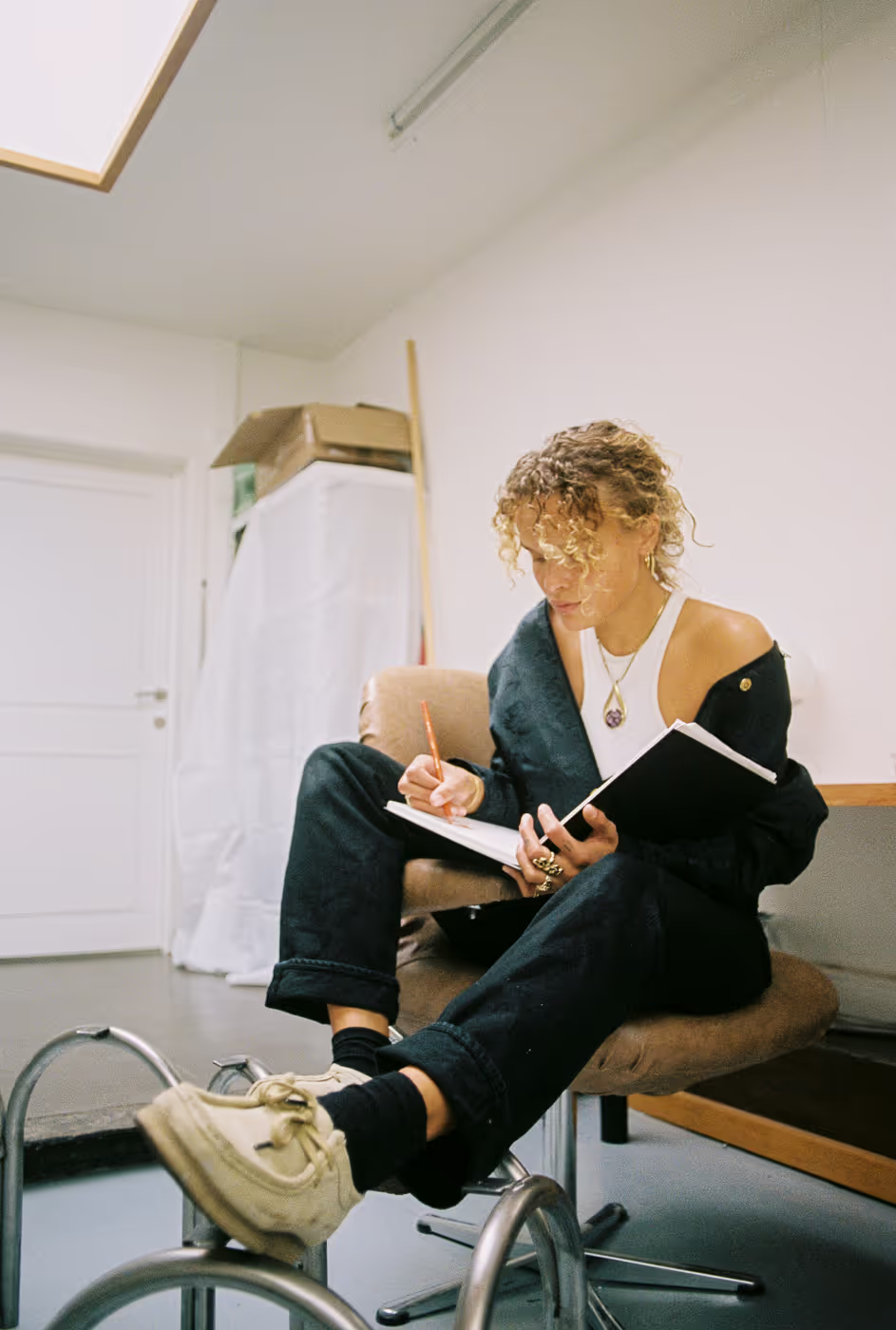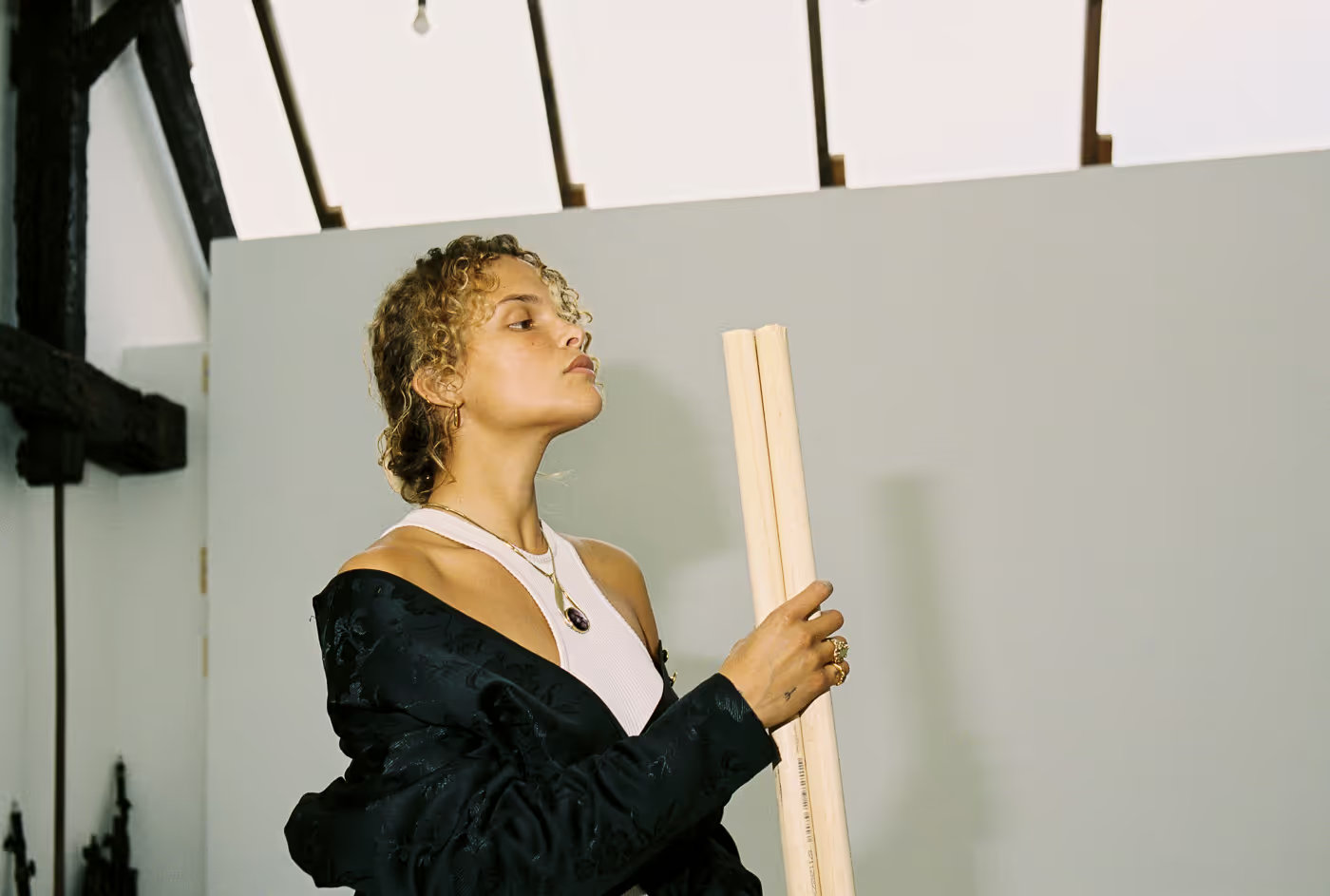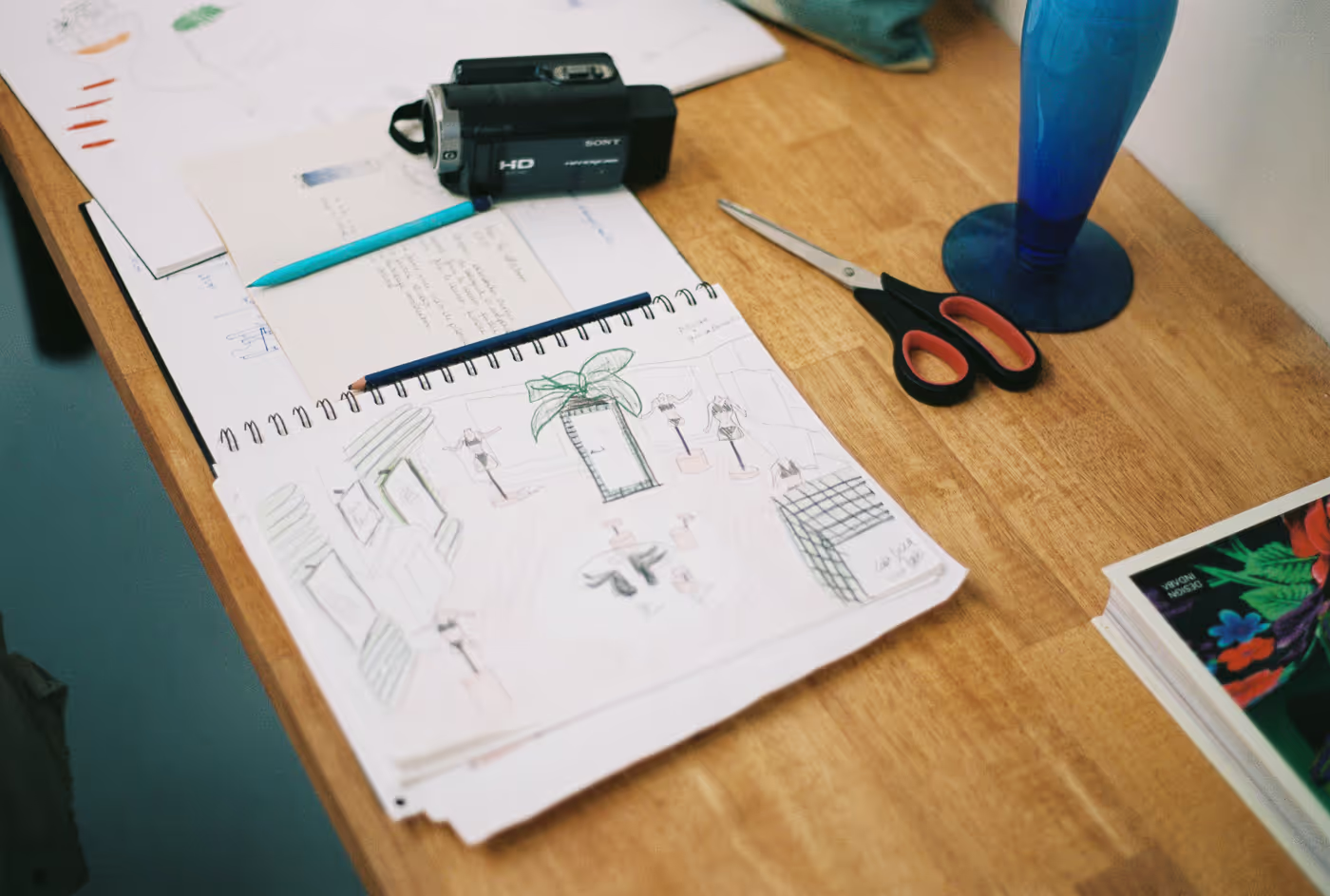





Words by Blurbs
Photos by Lukas Turcksin
Keytrade and Horst share DIY entrepreneurship as a common denominator. With ‘Their Way’ they inspire their shared philosophy through a content series. ‘Their Way’ offers the stories of DIY entrepreneurs at the forefront of art, architecture and music. We delve into the messy, yet inspiring and insightful process of entrepreneurship. We celebrate and feature compelling stories, challenging initiatives and examples of integrity from around the world.
Les Glacières de Saint-Gilles is a giant, buzzy warehouse with spaces for all kinds of craftspeople and cultural workers in Brussels: artists, carpenters, designers, welders, and photographers are all working away on this unassuming street in St. Gilles. This is where we meet Kenia Raphaël, a young designer, scenographer, and model who is launching a photo and video studio called Kocha Studio at the site. We caught up with her about fair pay, seeing beauty in imperfection, the importance of representation, and the difficulties of taking your first steps in the creative industry. She is taking action to provide an accessible space where young people can develop and share their work, and talks about the need to make space for your own creations.
{{images-1}}
Horst: Thanks for having us in your new studio. Could you tell us a bit about your background and your experiences at La Cambre studying interior architecture and design? How did that lead you to scenography?
Kénia: I studied interior architecture and design, yes. It was great, but La Cambre is really known for fashion, so sometimes we felt like the nerdy, quiet ones of the school, building models and stuff. I really liked the free way of teaching, they allowed us to experiment and pushed us to show our work in the craziest ways – you could paint or make something by hand as a model. Eventually I did get a bit frustrated in the program because we were never able to realize any of our projects. That’s how I fell in love with the scenographic world. Seeing how fast you can build a set and bring it to life. There’s definitely a link between the two fields. Interior design is about spaces that are functional, and aesthetic, of course, but they don’t change much. Scenography is about creating ephemeral spaces that only live on in your mind afterward. Interior design is technical where scenography is more emotional – so it’s two totally different jobs.
My shift to scenography came very naturally. I am quite impatient, so my teachers started to push me towards scenography. I got my first internship at the Théâtre National. That’s where I finally understood what I’m good at.

Horst: So you had a moment of revelation at the Théâtre National. Can you tell us more about what that was like?
Kénia: It was my second year at La Cambre, my first internship. I worked on a piece by Jaco Van Dormael and at the beginning, I didn’t understand anything. Like, why are we putting a chair in the middle of the stage? Why is the floor so important to you? Why did we take a whole week to place the floor? I didn’t get it. Then when I saw the whole show, I was like “wow”. I understood that my role alone as a stage designer doesn’t make sense, but together with the performer, the lights, the music… It was magical. There was one moment that will stay in my memory forever. You can’t find that anywhere else other than on stage.
Horst: Do you have any references or inspirations that are important for you? Who do you look up to in stage design?
Kénia: Yes! There is an agency in Paris called Bryant Artists, and they represent seven or eight set designers. They are so good, you can tell the ideas just pop out of their heads from nowhere. The job is underrepresented because we are behind the people behind the people behind the scenes. So when a person or agency becomes known, it’s very exciting. I am also inspired by Willo Perron in LA. He does everything with everyone, but he’ll never be as famous as the other names he works with. He does decoration, scenography, graphic identity… It feels very natural to combine these.
Horst: For your design work, if there’s one arena you would have to focus on, would it be music, theater or fashion?
Kénia: As a person, I prefer theater, but there’s no money there, so I cannot only work there <laugh>. I love performing and I love watching others perform. After theater, it would be fashion, the runway. It’s a type of performance as well, and magical in a different way.

Horst: How do you spend your free time?
Kénia: When I’m not working, I do nothing. Truly nothing. I just lay on my couch all day because I usually only get one day off per month. But I also need to find time to create just for myself. I spend so much of my life making other people shine, I have to remember to think about myself sometimes. I do like to be the client of my own projects, so I am doing more of those!
Horst: We are sitting in Kocha Studio, your new atelier in Brussels. Have you always lived in Brussels? What makes you stay?
Kénia: I love Brussels. I’ve traveled a lot and I used to live in different places, but I always come back here. I don’t know why but I feel like it’s an open field. I used to live in London and Toronto, and there are so many souls there already, so much energy. It’s so hard to find your place in those cities. I think it would be hard to believe that you have something to add or contribute to the scene there.

Horst: What is your personal approach to scenography?
Kénia: I am a very emotional and sensitive person, almost in a clinical way. I can sometimes be a bit absurd. My approach is about creating things that touch me. Sometimes I don't even find them beautiful. Like that fish bowl, it's ugly but I love it. When I see the terrible LED lamp inside and the fake flowers, I find it beautiful. I am a melancholic person, so every object I create carries that. I always imagine my objects in a certain space – let's say a dark space, with a good smell, where I am alone, there's a pink or red light, and I am touching a material that feels good. I want to design things in a slightly different way than we're used to seeing them. I am a big fan of plants and flowers, because they are uncontrollable. They are the only things I can accept not to control. I take a lot of inspiration from scenes in movies as well. I watch a lot of films and see something and then start drawing about it.
That's my process for my own creations. When I work for a client, it's much more technical, methodical, with a budget, mood boards, etc. The best part of my job is when people see something I created for myself on Instagram and ask to use it for themselves.

Horst: Is there a dialogue between your modeling work and your scenography work? Do they influence each other?Kénia: I think so. At first I was modeling only for the money until I realized it boosts my confidence a lot. As a designer, you always dress bad and smell bad because it's physical work and you don't have time to pick out your clothes. To counter that, it's nice to feel beautiful and to feel good. Understanding how to perform in front of and behind the camera helps me a lot as a designer and model. Right now, I do 50/50 modeling and designing, which is great. Though it is weird to be paid so much more to basically stand and convince everyone that you are beautiful. Design and scenography are still my favorites.Horst: How do you approach creation in terms of functionality vs. design?Kénia: Because of my studies at La Cambre, I always have a functional and technical way of thinking. I find it difficult to create purely decorative things that no one can use. Combining design and function gives you this infinite way of thinking and creating, it gives structure while allowing freedom. With the freezer bag, for example, it's a mess but I wore it to Paris Fashion week a few years ago and people were obsessed with it, everyone was looking at the bag. As I said, I am touched by things that are broken, and maybe that is my weakness. I can't even let others borrow it because the plastic scratches you when you put your hand inside. So, I used it, but now I just keep it as a memory. I could never give it away or sell it.Horst: Do you have a signature style or material that you like to work with?
Kénia: Definitely the galvanized pipe. I love this material because it is very cold, but it warms up really fast. It's so strong, yet really flexible. It's kind of my life mantra, to be like a steel pipe. Be strong yet flexible. You can bend it in infinite ways and it will never break. This material follows me and I follow it, it's a real relationship!
“My prices are based on my talent, not your budget. That’s my everyday life actually, having to explain to people why they have to pay and respect the work. People don’t understand that you don’t only work the day on set, you prepare in the days before.”

Horst: Can you tell us more in depth about some of your favorite collaborations?
Kénia: The project in C12 was really important for me because it was the link that brought me out of COVID and into my career. During COVID I was really broke, with no confidence, with no work lined up, and then this project finally gave me that opportunity I needed to start getting more jobs. I have so many nice memories of C12, but I loved this challenge of making people forget they were in a nightclub. Plus, I loved how it turned out. It was all about combining the industrial with the vegetable! It isn't the biggest collaboration I've ever done, but if I hadn't done that I don't think I would be where I am today.
Horst: We spotted a line on your Instagram that says, "My prices are based on my talent, not your budget." Have you had any challenging financial experiences or do you have any tips for getting paid properly?
Kénia: That's my everyday life actually, having to explain to people why they have to pay and respect the work. People don't understand that you don't only work the day on set, you prepare in the days before. It's always difficult having this discussion with friends. Plus, people don't acknowledge that your work is very physical when you're a pretty girl, for some reason that seems impossible to most people.If I have any tips, it's something my mom told me about accepting projects. It's a rule for having 2 out of the following 3 things: money, experience, and visibility. If you don't have at least 2, you should not be working on that project. I still accept unpaid work if it gives me good visibility and experience. Thanks, mom :)Horst: What social causes are you most passionate about?Kénia: This question is hard because I always feel like I can be doing more! But the truth is that I am a woman in two industries that are very hard. First with modeling, my body type is underrepresented. My body changes 11 times a year and I eat a lot, but I don't care. I am really comfortable doing modeling because I am offering an example of a realistic body type to other girls like me, where I didn't necessarily have that growing up. With scenography, I always work with girls only. If I am building a team, my assistants and collaborators are always women. I'm sorry but girls just do it better. That's it.
"Keep creating and accept imperfection. Sometimes you create things that aren't to anyone else's taste, but eventually, there will be one person who loves it. You just haven't met them yet! Finally, be indulgent about yourself."
{{images-2}}
Horst: Today you are opening Kocha Studios, a photo and video studio in Brussels. Can you explain your plans and what motivated you to embark on this project?
Kénia: I wanted to create a space where people feel free to come and share their work. I change my price depending on who is talking to me. If it's a new designer without money who needs help with lights and a pro studio, they will have a different price than someone else. I want this place to be affordable and accessible for young people. I did it for myself first because I needed to remember that I can create and show the work I do as well. I want to share that with others, too. You can rent the studio, I can be there to help, and I also work here as my office when it's not rented. I felt that Brussels was really missing a space like this, and I want to help build that community.I am also working on a 3D printed plastic and steel furniture concept with a friend, Thibaut Baes. I am putting almost 4 years of work into this project. I'm excited! Unlike my other scenographies, this furniture has to be technically perfect.
Horst: Our favorite last questions: where do you see yourself in 5 years and any last words of wisdom?
Kénia: The thing is that I am excellent in nothing, but good in Many things – so anything is possible, it's really difficult to say. I could be running a restaurant because I love to cook. I am going to keep creating things for myself, that's for sure. As for advice, keep creating and accept imperfection. Sometimes you create things that aren't to anyone else's taste, but eventually, there will be one person who loves it. You just haven't met them yet! Finally, be indulgent about yourself.
{{slider-1}}




